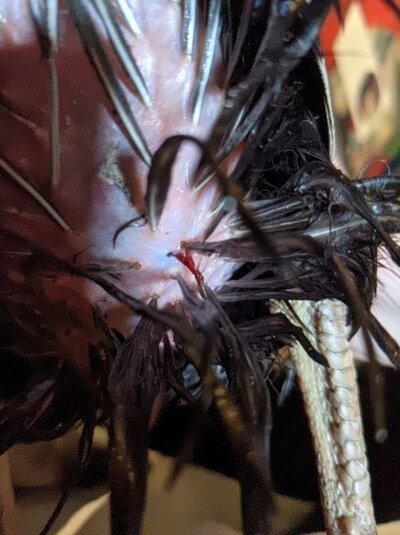Hello all my lovely chicken folks!
I have a bit of an advanced question for y'all regarding water belly. I'm completely bewildered by this one so maybe one of you smarties could help?!
IN A NUTSHELL:
The patient is a 2 year old silver laced Wyandotte named Celosia (after the flower). She has had fluid accumulating in her abdomen for about 18 months now and I've drained her successfully with 18g x 1" hypodermic needles 5 times. I've never had a problem getting the fluid to flow out freely, but this last time, when I stuck the needle in, the plunger wouldn't draw back. I stuck her 4 different times, in slightly different locations (to the right and down from the vent) but each time I just got a vacuum and was unable to draw any fluids or even pull the plunger back.
Nevertheless, I'd still get a drip or 2 of clear liquid after withdrawing the needle, so I know it's in there. Maybe I'm just going in too deep, but she's got a big ol squishy belly, so that seems like missing the broad side of a barn to me.
Anyway, I've ordered 1/2" and 3/4" needles based on this hypothesis, but definitely curious if any of you have seen this before?
EXTRA DETAILS:
The fluid always comes out almost perfectly clear with only a faint musty odor. No yellowish hue.
I'm confident in the diagnosis based on her history and the fact that she's showing the same classic symptoms again:
*swollen & distended abdomen that is soft, squishy and feels full of liquid
*waddling when walking
*labored breathing, even at rest
*lethargy & lack of appetite
* hanging out on her own more and more
PAST RESULTS:
She's shown signs of improvement after each draining:
Her first drain released 1.2 L w 6 weeks before the next drain was needed
Her most recent drain released about 0.3L and it took 6 months to accumulate enough to need another
Ooookay, that's all I can think to include here. I'd be very grateful for any input from y'all. @azygous I know you really know your stuff... any thoughts here?
Thanks and stay safe and don't forget to share some eggs w your neighbors y'all!
- Zac
I have a bit of an advanced question for y'all regarding water belly. I'm completely bewildered by this one so maybe one of you smarties could help?!
IN A NUTSHELL:
The patient is a 2 year old silver laced Wyandotte named Celosia (after the flower). She has had fluid accumulating in her abdomen for about 18 months now and I've drained her successfully with 18g x 1" hypodermic needles 5 times. I've never had a problem getting the fluid to flow out freely, but this last time, when I stuck the needle in, the plunger wouldn't draw back. I stuck her 4 different times, in slightly different locations (to the right and down from the vent) but each time I just got a vacuum and was unable to draw any fluids or even pull the plunger back.
Nevertheless, I'd still get a drip or 2 of clear liquid after withdrawing the needle, so I know it's in there. Maybe I'm just going in too deep, but she's got a big ol squishy belly, so that seems like missing the broad side of a barn to me.
Anyway, I've ordered 1/2" and 3/4" needles based on this hypothesis, but definitely curious if any of you have seen this before?
EXTRA DETAILS:
The fluid always comes out almost perfectly clear with only a faint musty odor. No yellowish hue.
I'm confident in the diagnosis based on her history and the fact that she's showing the same classic symptoms again:
*swollen & distended abdomen that is soft, squishy and feels full of liquid
*waddling when walking
*labored breathing, even at rest
*lethargy & lack of appetite
* hanging out on her own more and more
PAST RESULTS:
She's shown signs of improvement after each draining:
Her first drain released 1.2 L w 6 weeks before the next drain was needed
Her most recent drain released about 0.3L and it took 6 months to accumulate enough to need another
Ooookay, that's all I can think to include here. I'd be very grateful for any input from y'all. @azygous I know you really know your stuff... any thoughts here?
Thanks and stay safe and don't forget to share some eggs w your neighbors y'all!
- Zac






